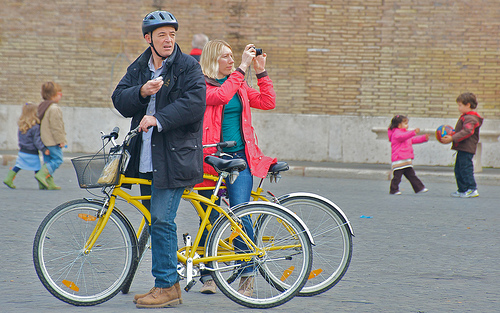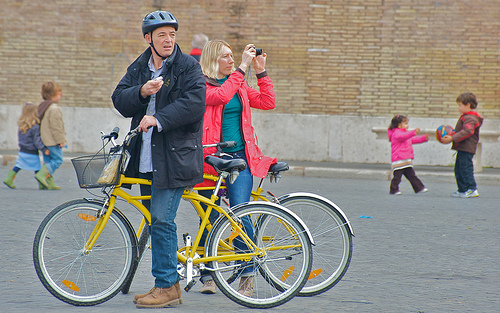 Which one of them is making the right choice?Photo: Ed YourdonThere’s a burgeoning worldwide anti-bicycle helmet movement. Troops are mobilizing, talking points in hand. This movement recently reached a crescendo in a well-circulated video of a talk titled “Why We Shouldn’t Bike With a Helmet.”
Which one of them is making the right choice?Photo: Ed YourdonThere’s a burgeoning worldwide anti-bicycle helmet movement. Troops are mobilizing, talking points in hand. This movement recently reached a crescendo in a well-circulated video of a talk titled “Why We Shouldn’t Bike With a Helmet.”
Equally fervent are the pro-helmet advocates around the world. In many places, they are backed up by laws mandating helmets either for children or for everyone who rides a bicycle — most recently, and with amusing effects, in Dubai.
As in the battles waged on the U.S. Senate floor, both sides claim rationality and cultural superiority for their own. The opponents are engaged in a bloody, winner-take-all contest, with little talk of compromise and perfect willingness to let ideology wash away all science and common sense.
The most entrenched positions are best exemplified by websites from each side of the helmet aisle. The Bicycle Helmet Safety Institute promotes bicycle helmets with a drab, authoritative-looking deluge of information. Excerpts from statistical analyses sit alongside hairstyle advice; wrenching stories of injury and loss are featured near a handy guide for drafting a mandatory helmet law for your municipality. A page that purports to give a balanced view of anti-helmet perspectives entertainingly does anything but.
On the other side, an equally confounded mix of science, propaganda, and cherry-picked news stories can be found at the Bicycle Helmet Research Foundation‘s website. This side in the helmet wars is growing, and a similar mixed bag of one-sided evidence, though without the wingnutty exposition, can be found from sources such as the UK’s primary cycling organization.
The fact is that good and interesting data exist to support both arguments, though not enough to be as conclusive as either side would like. A 1989 study in the United States found that helmet use decreased the likelihood of head injuries by 85 percent. More recently, a study in Portland (which I wrote about here) gave the pro-helmet lobby a boost by showing a slight but statistically significant benefit in avoiding the need for medical attention when seasoned daily bicycle commuters wore a helmet. These studies do not — and perhaps this should be in bold — do not adequately show that helmets provide significant protection against head injuries. For instance, less well-publicized studies show that these results might be due to helmet wearers being more safety conscious.
Other data has been used, more or less compellingly, to demonstrate direct personal dangers from wearing helmets. Some studies show that in some types of crashes, helmets can cause increased injuries by amplifying rotational forces on the brain. Another, somewhat eccentric, study, done by a British psychologist with himself as his only test subject, found that he was given several more centimeters of space by passing drivers when not wearing a helmet — and yet more when wearing a flowing wig. The body of research showing the dangers of helmet use is not conclusive, either. This should probably be in bold, too.
There are many more studies that are brandished in attempts to influence people’s choices in helmet wearing — far more than I can list here. And there are those far more dedicated to listing them than I. The data on both sides is, like most current bicycle transportation findings, weak and inconclusive; certainly none of it is worthy of the triumphant finality each side in the helmet wars attaches to their favorite studies.
The face of the anti-helmet movement is Mikael Colville-Andersen, the speaker in the video linked in the first paragraph. Colville-Andersen, who lives in Copenhagen, launched his career as an influential bicycle blogger by posting snapshots of attractive Danish women (and men) on bikes, and now travels the world expounding quotably on the way he thinks cycling culture ought to be organized and marketed.
One of Colville-Andersen’s favorite targets is bicycle helmets. Despite the iffy statistics and eye-catching conspiracy theories in his now-famous anti-helmet talk, he makes some compelling points when he digresses from advocating against the actual wearing of helmets and focuses instead on what he calls a “culture of fear.” Why, he asks, do we view bicycling as imbued with danger, but not walking or driving — when you can get killed doing those, too? If fear causes us to stay sedentary, won’t that kill us faster? He has a point.
Colville-Andersen is most convincing when he levels his ire against mandatory bicycle helmet laws. In general, discussions of such laws tend to be fairly even-keeled. And the case against helmet laws is made more compelling simply by being made in a way that doesn’t confuse it with the emotionally charged arguments for and against actual helmet-wearing.
Australia has had a mandatory bicycle helmet law since 1992, and the country is at the center of anti-helmet-legislation activism. Opposition to the helmet is quite organized and spirited, particularly around the concept of Safety in Numbers (which I wrote about here). A 2009 economic analysis uses externalities to make the case that the harm to public health due to decreased ridership is far greater than any protective benefit helmets might afford.
On the other side, the only study I was able to find showing the benefits of a mandatory helmet law is a 1980s study from New Zealand showing that when helmets were mandated, while children suffered more bicycle-related injuries, fewer of them were head traumas.
Once again, the evidence is thin, the arguments are passionate, and the data can (and certainly will) be used to prove any point. And we, the public, are left just where we would be without any of it — choosing to wear a helmet or not based on social pressures, cultural norms, anecdotal accounts, and compelling emotional arguments made on both sides.
Personally, after all this research, I remain most swayed by the point that the great helmet question is the wrong one entirely to be asking.
When bicycle safety is treated like a war of attrition, with every soldier responsible for her own body armor, we all lose. When we can freely ride on streets
where we are not threatened with deadly violence at every moment, we all win.



